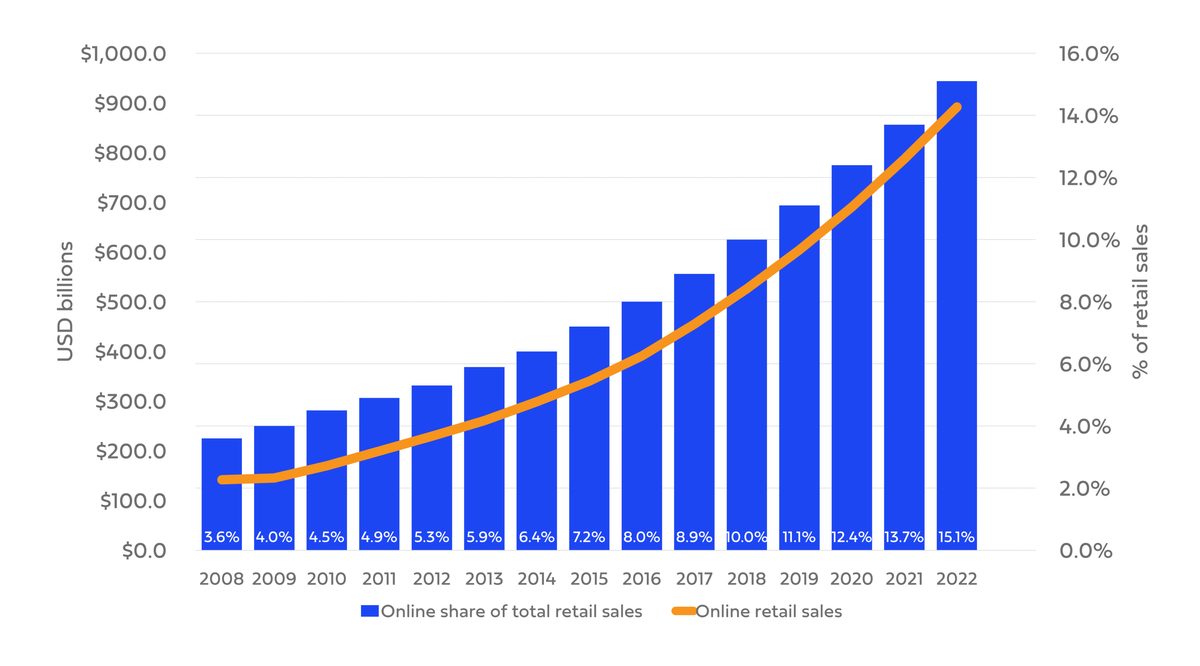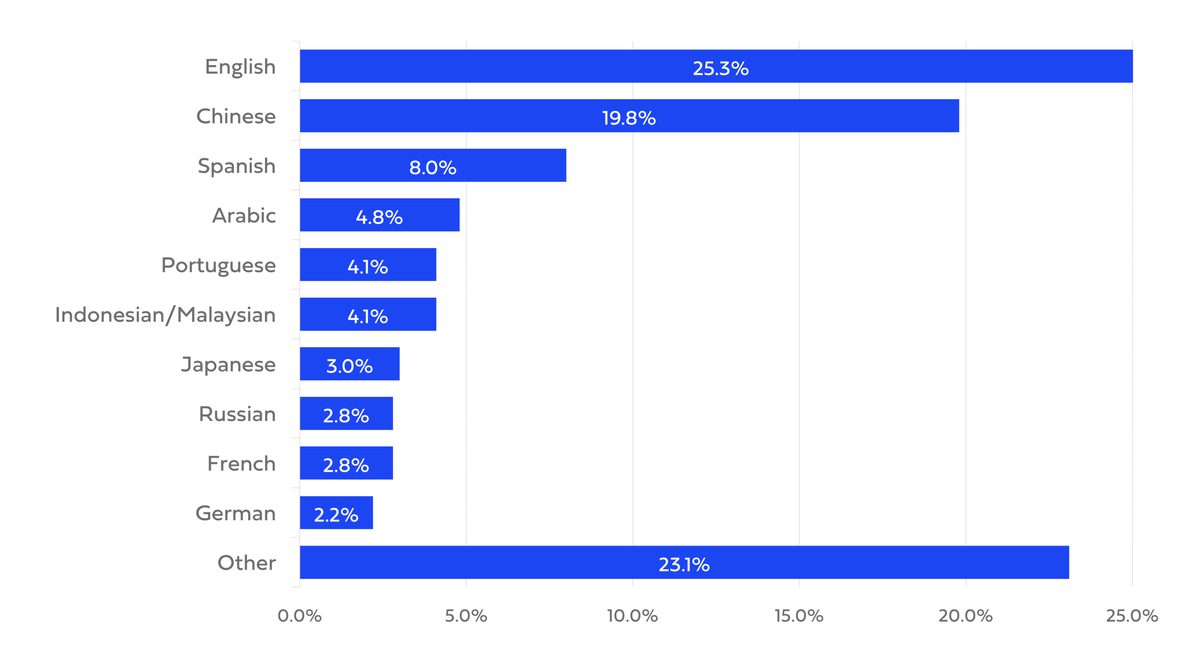
How to increase international traffic to your e-commerce store?
As e-commerce sales continue to spike globally across all sectors, businesses are gradually approaching the point at which online transactions will outweigh physical ones. This is due in part to customer demand for an omnichannel holistic shopping experience where the majority of commerce takes place over the web, while physical stores turn into showroom brand experiences. The following graph shows how quickly this growth is accelerating, with 15% of all total retail predicted to be via e-commerce by 2022. It's forecasted that US e-commerce penetration is now expected to grab 34% of all retail sales.

For some sectors, that’s already overwhelmingly the case, and in these areas, businesses are competing in an increasingly crowded marketplace. To beat the competition, owners of e-commerce stores are seeking to expand their total addressable market by promoting their sites to a wider global audience.
Although the very nature of e-commerce allows a web-based store to be accessed by anyone in the world with an Internet connection, gaining customers in new territories is not as simple as relying on the old mantra “If you build it, they will come.”
Achieving global success with an e-commerce business requires careful preparation in a range of different areas, from translation to localisation, from optimising the user experience to choosing the right service partners, and much more.
For example, the most popular language used online is English, but it only represents just over a quarter of all language use on the Internet. So translation is vital for businesses who wish to access the other 75% of connected users (currently standing at around 3 billion potential customers!)

Translation is perhaps an obvious point, but there are many more things to take into consideration, some of them not so immediately obvious. Read on to discover our top 10 tips for e-commerce businesses who are looking to grow their international traffic, conversions and sales, and to succeed in new markets.
TL;DR
- Align your business goals & website traffic sources
- Localise your online store’s user experience for countries you’re willing to target
- Add multilingual chat support
- Ask for reviews and translate them to build trust
- Use SEO to increase your store’s international reach
- Use multilingual content marketing to attract new visitors
- Reach new audiences with influencer marketing
- Start a referral program
- Localise your promotional email campaigns
- Run native language PPC ads
Tip 1 - Align your business goals & website traffic sources
Reading statistics like the ones mentioned above can be daunting for anyone looking to expand their business online. With a total of just over 4 billion Internet users around the globe, or almost two-thirds of the world’s population, it can be hard to envisage how to go about engaging with them. Which areas should you engage with first, and where is your new addressable market?

Where many businesses get this wrong is in trying to spread the net too wide. Of course, Google, Amazon, Microsoft and other global businesses have the resources and expertise to provide websites for every language, writing system and region, but how can smaller companies compete?
The answer is - by focusing on strategic target markets. Rather than growing global traffic, focus on one or more specific regions which align with your business goals, which have a need for your product or service, or which are linked to your current market(s) in a logical way.
The first step is to assess the status quo. Use a tool like Google Analytics to review the current sources of inbound traffic to your site, and which countries it originates from. This will allow you to start building useful insights into where you should invest your time and effort in translation or localisation.
Let’s consider an example: Company X has an English language e-commerce site selling t-shirts. Most of their customers come from the UK, however, when they review their traffic, around 10% of visitors come from Italy, and although the conversion rate is lower than for the UK visitors, they are providing a share of revenue. Is Company X missing anything about the potential Italian market?
The second major tool for companies looking to bring some focus to their international marketing strategy is market research, which may reveal countries or regions where your product or service would be popular, but you’re not seeing any traffic from those areas yet, because you haven’t localised your store for those visitors - creating a barrier to access.
Effective market research allows you to identify potential markets and evaluate the likelihood of success before you commit to significant marketing spend in those areas.
Key points to consider:
Use analytics software to identify markets showing current interest in your store, and pair this with market research to identify markets which are likely to have a future interest in your store. Combine this information to make an informed decision on which areas to target and in what order.
Tip 2 - Localise your online store’s user experience for countries you’re willing to target
Once you’ve identified the countries or regions which you wish to target, the next step is to localise your store to optimise the user experience for those visitors. A common mistake which businesses make at this stage is thinking that localisation is simply a matter of translating some or all of the content, and maybe hosting the translated version of the site on a country-specific domain.

One of the vital parts of preparing your site for international visitors is correctly localising your brand voice, particularly if you use colloquialisms or informal language in your copy. Specific words or phrases may differ in their precise meaning between dialects or sociolects of the same language.
The more “at home” you make your audience feel, the higher your conversion rate will be and the more likely you are able to generate recommendations and repeat business. There are few areas to consider to achieve this.
Text copy
As well as translating any text on your site, you may also need to consider norms around text direction, text alignment and other attributes of formatting. Even different English speaking territories have different approaches to seemingly unimportant aspects of text editing, such as the capitalisation of words in headings, the use of punctuation and how tables or lists are laid out. With other languages, these differences may be magnified.
Even more importantly, you need to localise your content to ensure the correct use of any colloquialisms, cultural references, product names, slang or humour. This is vital if you want to ensure that your brand voice is accurately represented, and no misunderstanding or changes in meaning are introduced. The only reliable way to do this is using a professional transcreation partner with specific experience and expert staff operating in your target language.
The important thing is that your target visitors see a layout which is familiar to them and reflects the way they use the language themselves, as this helps to build trust and enhances the overall user experience. The easier you make it for them to move around the site, view and compare products and eventually purchase, the more likely they will be to do so.
Imagery
Images don’t need to be translated, they are universal, right? That’s another common assumption which is unfortunately inaccurate. Around the world, attitudes to what type of imagery is or is not appropriate vary greatly.
For example, cultural taboos may preclude the use of certain images in advertising products or may restrict the way in which human models are dressed, or the behaviours they are depicted as partaking in.
On a more general level, visitors to your site will appreciate seeing photography which reflects their local culture and demographics, so you should think carefully about the diversity of the people, landscapes and landmarks featured in any images you use and whether they are representative and respectful of your target audience.
Video
Video production is one of the most expensive types of content creation, and therefore the approach you take to localisation of video resources will depend on the budget or time you have available.
At a minimum, you should ensure that any video asset used on your website has subtitles available in the appropriate language, allowing visitors to fully understand and engage with the content.
For greater engagement, you should consider providing a target language voiceover, recorded by a native speaker. This allows you to reuse the same content for different markets without having to reshoot or reanimate the video.
Ideally, you should create specific videos for each target market. While this is the most expensive option, it allows you to translate and localise any terminology, labels or headings within the video itself, as well as more accurately syncing the audio with what your audience sees on screen. As we discussed above regarding imagery, you can also ensure that the visual elements used fit the cultural expectations of the viewer.
Units of measurement
Whatever product or service you are offering, the likelihood is that you will include some information which involves units of measurement - the dimensions of a product, the sizes of clothing or footwear, the specifications of electronic goods, and so forth.
Not all units of measurement are universal, and it’s important that you adapt the way you present this information so that it can be interpreted correctly by your international visitors.
If it isn’t possible to change every instance of a unit of measurement, you could consider including a conversion chart to allow visitors to make the comparison themselves. For example, on a clothing site, including a chart which shows the equivalent women’s clothing in the various different measurement systems used around the world.
| Women's clothing sizes | ||||||
|---|---|---|---|---|---|---|
| UK | US | Japan | France, Spain & Portugal | Germany & Scandinavia |
Italy | Australia & New Zealand |
| 6/8 | 6 | 7-9 | 36 | 34 | 40 | 8 |
| 10 | 8 | 9-11 | 38 | 36 | 42 | 10 |
| 12 | 10 | 11-13 | 40 | 38 | 44 | 12 |
| 14 | 12 | 13-15 | 42 | 39 | 46 | 14 |
| 16 | 14 | 15-17 | 44 | 40 | 48 | 16 |
| 18 | 16 | 17-19 | 46 | 42 | 50 | 18 |
| 20 | 18 | 19-21 | 48 | 44 | 52 | 20 |
Failing to provide the right information on measurements to your customers isn’t just poor customer service, it can also lead to increased costs as buyers return goods which they purchased in the wrong size, so it’s vital that you get this right.
Currency
One of the most obvious differences when selling across geographical borders is currency. While some online retailers will only list items in their local currency, this provides a substandard experience for international customers. Requiring them to compare and convert prices can lead to confusion and potentially lost sales as buyers are not confident in understanding the real value of the product or service on offer.
To ensure that prospective customers are comfortable using your store, it’s crucial that pricing information is displayed in their currency of choice, and that any documents such as invoices or receipts also reflect this. Correct formatting of prices is also important, using the right symbols to mark decimal places, which varies by country, as well as the correct placement of currency symbols.

Payment platforms
Ensuring that the purchasing process is as convenient as possible for your international customers is not only a matter of displaying the correct currency, you should also consider the methods of payment available.
While many sites offer internationally recognised payment methods such as credit cards, bank transfers or PayPal, it’s important to recognise that different countries may have their own particular methods, and customers from those regions will expect to be able to use their preferred method.
For example, although PayPal is one of the more popular payment methods in the US and UK, in France, Paylib is the market leader, with 40 million users versus only 7 million for PayPal. So for e-commerce businesses selling to French customers, ensuring your store accepts Paylib opens up more of the potential market.
Aftersales
Localisation doesn’t begin and end with your on-site content. To provide a consistent customer experience, it’s important that you apply the same principles to communications made outside of the website, such as signup emails, payment confirmation messages or SMS notifications.
Nothing is more frustrating to a customer than completing a purchase and then receiving shipping or delivery information via email in a language they don't understand. To deliver a consistent brand experience, it’s crucial that every step of the customer experience has been properly localised.
Key points to consider:
Localisation doesn’t just mean getting the language right, it means respecting cultural differences in a range of extralinguistic areas such as images, measurements and currencies, as well as choosing the appropriate tools, such as payment systems, that are familiar to your prospective customers and make the purchasing process easy for them.
Tip 3 - Add multilingual chat support
Recent advances in AI technology, specifically when it comes to language processing, mean that using automated chatbots to communicate with visitors to your site is an increasingly valid and reliable option. This is particularly valuable for e-commerce businesses selling into multiple countries, offering immediate and seamless customer support that is key to providing a unique experience across all sales and marketing channels.
Bots are increasingly popular with customers, with as many of 70% stating that they expect businesses they shop with to provide a self-service interface online, and 51% saying they are more likely to purchase from a site with a chat function available.
Marketing software giant HubSpot reviewed the available AI chatbots and selected a list of the 7 best options for online businesses looking to add chat capability to their on-site customer interactions.
- Watson Assistant
- Bold360
- Rulai
- LivePerson
- Inbenta
- Ada
- Vergic
While each of them varies slightly in the specific feature set available, the core functionality is similar, deploying natural language processing, machine learning, custom dialogue paths and sentiment evaluation to offer a human-like experience for your visitors.
Bots can be deployed to assist with qualifying leads, answer frequently asked questions, help prospective customers to find detailed information on products, troubleshoot any issues with the ordering process and generally provide a “personal touch” at the first point of contact.
Key points to consider:
Using a multilingual chatbot can reduce costs as there’s no need to hire specialist staff, and allows you to better personalise the user experience on your website. The majority of customers welcome the opportunity to use a self-service interface such as a bot, and this is reflected in an increased desire to purchase from online stores with this function available.
Tip 4 - Ask for reviews and translate them to build trust
Social selling is an extremely important part of any e-commerce operation, as potential customers rely on reviews and scores from people who have previously purchased a product or service to inform their decision. Ensure that customers are encouraged to leave a review and rating on any purchase, both on-site, social media platforms or and in any follow-up communication you use. Make it convenient for them to engage.

When entering a new market, you may not yet have recent reviews in the new target language, but it is possible to leverage existing reviews by using machine translation to display the original text in the new target language.
However, it’s worth bearing in mind the limitations of automated translation tools, particularly when it comes to customer reviews, which are characteristically informal in style, may contain strong emotions, slang or even profanity.
All of these may pose problems for machine translation, particularly where the language engine has been trained only on formal corpora. You should work with a translation partner which has trained engines for this kind of work, and can advise on selecting the most effective reviews to translate.
There are workarounds, for example, using filters or blacklists to ensure that any offensive language is blocked, or alternatively, a blended model of machine translation combined with a human reviewer to check for any incorrect translations. As machine translation tools continue to improve, the need for human intervention will decrease, but currently MT alone is incapable of correctly translating nuanced or non-standard language 100% of the time.
Key points to consider:
Leveraging your existing customer reviews by translating them into new languages is an effective way to build trust with prospective customers. While the most economic method is undoubtedly machine translation, it’s important to understand the limitations of automated translation tools, and adding an extra layer of human quality assurance may be advisable.
Tip 5 - Use SEO to increase your store’s international reach
The most effective way to boost organic inbound traffic to your website is via SEO, and most e-commerce sites will already have a SEO strategy in place to achieve this. When targeting international traffic, it’s important to ensure that your strategy is focused on the specific markets in which you are planning to sell. The top three search results on the average search page receive over 55% of all clicks, so reaching those key positions for relevant search terms is crucial in generating inbound customers.
Text content
Optimising titles, meta descriptions, URLs and headings is an important part of on-page SEO. It is mandatory to have both elements translated and localised.
Performing a one-to-one translation on these key items runs the risk of losing the relevance or effectiveness of the originals, so some degree of localisation is required to ensure that the detail and nuance of the meaning has been preserved, and the search terms which you are targeting are relevant in the local language.

Image optimisation
One important aspect of SEO which a lot of businesses miss is image optimisation for new languages - it’s easy to reuse the same product images for each language version of the site. However, to compete in search rankings in your target language, you need to make sure that image captions and alt attributes are correctly translated and formatted.
There’s more to consider than simply translating the image - you may need to research how descriptions are typically formatted in your target language, for example in English, there is a specific order of adjectives (opinion-size-age-shape-colour-origin-material-purpose) which means “blue woollen winter coat” is correct, whereas “winter blue woollen coat” or “woollen blue winter coat” is not.
By contrast, in Japanese, the normal practice is to order adjectives by the quality you want to emphasise the most in that particular sentence. There’s no universally correct order so you should place the adjectives which describe the most important features first.
These specifics vary by language, and if you get them wrong, you’ll miss out on key search traffic.
Link building
Following the same principle, your link building strategy, which is key to off-site SEO, needs to be adapted to the specific countries or regions which you have targeted as part of your international growth strategy.
Rather than adopting a scattergun approach, take the time to properly research the influential communities within the target markets you wish to operate in and work out how you can create high-quality, linkable content which will attract their attention. We’ll talk more about promoting your multilingual content in Tip 6 below.
Performance
The performance of your website, in terms of the speed at which pages and images load, and the response time when selecting products, building a shopping cart or making payments, is important not only for the customer experience but also for SEO.
Search engines penalise sites which take too long to load, so it’s worth benchmarking your site using one of the free tools available and ensuring that any problems are fixed. Common issues include using images which are too high-resolution, loading unnecessary scripts, failing to optimise your CSS or hosting too many adverts on site.
For e-commerce stores selling internationally, it may also be worth reviewing your hosting to ensure that your site performs equally well in each of your target countries. A site which loads quickly in London might not perform as well when visited from Tokyo, especially if it is located on a single UK server.
This may involve setting up a content delivery network (CDN) or distributing your site and database across multiple servers, especially when your potential customers may be located on the other side of the globe.
Key points to consider:
In order to reach the optimum position in search rankings for a new target language, you need to review all aspects of your SEO strategy and tailor them specifically to that language, rather than attempting to take a shortcut by making like-for-like replacements of the original. From optimising text and images to reaching out to influential sites for inbound links, each part of the strategy needs to be focused and localised.
Tip 6 - Use multilingual content marketing to attract new visitors
To succeed in ranking for your desired search terms, it’s not enough to pursue the traditional SEO strategies described above. They represent an important foundation, but on top of that, you need to produce regular, relevant content which engages and attracts readers, and which they feel enthused to share.
Localising existing blog content
Content production requires a substantial amount of resources, so rather than creating large amounts of new content from scratch in a new target language, it’s worth reusing existing content if you have it. You don’t need to go to the expense of translating your entire archive, in fact, it’s probably not the most effective approach.
Instead, use a tool such as Google Analytics to review your existing content and look for top-performing blog posts or articles.

Prioritize the localisation of the articles found based on their key performance indicators: unique pageviews, average time on page and bounce rate. First and foremost, localise those articles that have the highest number of unique pageviews, the longest average time on page and the lowest bounce rate. In a recent blog post, marketing guru Neil Patel discussed how he was able to achieve an almost 50% increase in traffic to his site by identifying the highest performing posts which had attracted international readers and having them professionally translated.
Crafting new content
When creating new content, the best approach is to have it written by a native speaker from scratch, so that it is localised from the beginning. You should do some research to pick topics which will be of particular relevance to your audience, which may differ from country to country, even if you are promoting the same products and services.
The maturity of the market will help to determine what type of content performs best. Informative articles might work well in one country to educate the market, whereas in a more developed market where potential customers are knowledgeable about your offering, how-to guides may perform better. There’s no one-size-fits-all answer, you’ll need to research what works for your sector, and with your audience, in each language.
There is one constant - whatever type of content you create, you need to ensure that it can be easily shared by your readers, which is a key aspect of building your reputation and brand. Add social share buttons, but don’t just use the default Facebook, Pinterest, Twitter and Instagram. Find out which are the most popular social networks locally, it can vary quite widely and make sure that you include prominent sharing options for each of them. For example, Weibo, WeChat, Youku are the most popular social media platforms in China.
Key points to consider:
Content creation and localisation can be expensive, but it’s worth investing some budget on your highest-performing assets. Local knowledge is also important when it comes to encouraging your readers to share content - make sure their favourite networks are represented.
Tip 7 - Reach new audiences with influencer marketing
One of the most effective ways to distribute your content and build your brand and reputation in a new market is via influencer marketing.
Social media
Depending on the specific product or service you offer, influencers on social media sites may agree to feature your content in exchange for promotional items or considerations, or you may have to negotiate a standard payment along the same lines as traditional advertising.

In either case, the most important factor is identifying the influencers who have the most relevant audience for your offering. It’s far better to promote your store via an influencer with 100,000 highly engaged followers who are interested in the products you sell than one who has 10 million followers who are not part of your target demographic. Research the platforms which are most used by your desired audience in the country in which you are trying to build traffic.
The most popular platforms are not always the best strategic option - there may be niche networks with specific interests which overlap with your products.
Content placement
Influencer marketing isn’t restricted to social media personalities. You can also look for influential bloggers, writers or website owners whose readers might be potential customers of yours and place content with them, either through reaching out to offer relevant guest posts or as part of a commercial arrangement in the form of advertorial pieces.
For this type of content marketing, it’s always worth investing in your own original content, written by a native speaker who is based locally and has some expertise in the topic of interest. This ensures that you capture the correct tone, style and voice to engage your audience, and build fruitful relationships with influencers and their followers.
Key points to consider:
Take the time to research who the key influencers are in your field, which social networks, blogs, or websites they are active on and how closely the makeup of their audience matches your ideal customer. The more closely targeted your influencer marketing is, the more effective it will be in generating high-quality inbound traffic to your store which has a high chance of converting.
Tip 8 - Start a referral program
If you already have a number of international customers who speak the language you are targeting and live in the region or country of interest, starting a referral program is a great way to leverage their relationship with you while rewarding them for their loyalty.
There are a number of ways to incentivise customers to provide you with referral traffic, and the most effective one will depend on the exact nature of your product.
A good example of a referral scheme in action is the incentive offered by Netflix, whereby if a customer refers a friend, and that friend signs up, they can receive a month of free service.

Rather than a voucher, you can also offer customers free products or limited edition items in return for successful referrals. Harry’s, a grooming brand, took this to another level by adding a competitive element to their referral scheme in which increasingly valuable free gifts were available once customers reached 5, 10, 25 or 50 referrals.
For subscription based services, you can offer customers an enhanced service if they persuade their friends to sign up.
Dropbox offers subscribers 500MB of extra storage space for each of their referred contacts who signed up for an account. With this type of offer it’s usually wise to set a maximum reward (as Dropbox did, capping it at 16GB, or 32 referrals).
Referrals are an ideal way for e-commerce companies to introduce their brand to a new market. But for them to be truly effective, you do need to make sure that all the collateral involved in the program - landing pages, emails, forms etc is properly localised to make it as easy as possible for your potential referrers to understand the benefits and motivate them to get involved.
Key points to consider:
Design a referral program which suits your business model to get your most enthusiastic customers working for you, promoting the brand or product to new customers in a trustworthy and personalised manner. Remember to make sure the program materials are localised so there’s no misunderstanding about how the program works.
Tip 9 - Localise your promotional email campaigns
Promotional emails are a vital part of communicating with current and prospective customers, but it’s important to remember that with a direct and personal form of communication such as email, proper localisation is absolutely crucial.
There are a few different areas where you should consider your audience and tailor your communication to their linguistic and cultural norms. It’s not just about pleasing the customer either, effectively localised promotions show higher clickthrough and conversion rates - so they are better for your bottom line.
Language
As well as translating your message into the target language, you also need to ensure you correctly localise the style and tone. Even something as simple as a greeting line such as “Hey there!”, which might seem friendly to a recipient in the USA, might seem disrespectful if translated directly into Mandarin or Vietnamese.
The more you wish to use colloquial language, informal terms or humour, all of which are important constituents of customer-centric emails, the more important it is that the localisation is done correctly, either by a native speaker if you have one on your team, or a professional agency who has experience delivering complex and creative localisation projects.
Layout
The layout of your emails should also be customised to suit your audience. Different cultures prefer different types of email. A good illustration of this is the regular customer newsletter sent out by makeup brand Sephora.
The version sent to US recipients is quite stripped down and simple, whereas the version sent to members in Italy is much more detailed, with more text and links to products. Through research and testing, the company has evaluated which style works best in which culture.
Visuals
As mentioned in Tip 2, cultural norms around imagery vary from country to country. Extremely religious or conservative cultures may not appreciate images of bikini clad models in their newsletter, whereas in more liberal cultures this wouldn’t be an issue.
Similarly, recipients living in tropical countries probably wouldn’t be interested in a skiwear sale. It’s important to customise your communication for each market, and not try and adopt a one-size-fits-all approach.
Key points to consider:
Email is a personal medium, so take the time to customise your promotional messages as accurately as possible, bearing in mind the linguistic, cultural and geographical differences between the different groups of subscribers on your list.
Tip 10 - Run native language PPC ads
Organic SEO and content marketing campaigns can take some time before they start to show a return. One way to fill the gap when entering a new market, or a quicker way to test the water when comparing more than one region to find out the best one to target, is to use pay-per-click advertising.

Most social media platforms and search engines offer some sort of PPC advertising program, whereby you create a text, image or video based ad, and you are charged a fee whenever someone clicks on it.
The nature of PPC means that it is vital to design and localise your ad in such a way that it accurately targets your prospects - you don’t want to waste your click budget on visitors who clicked through but then didn’t like the product or service you were offering.
If you’re new to pay-per-click advertising, there are a number of free guides available online to help you get to grips with the major platforms out there, although remember to research whether there are more popular local alternatives in your target market.
As the world’s most popular social network with over 2.5 billion users, it’s likely that your potential customers will be on Facebook already. Their ad tool allows you to narrow down the focus of your promotion by various categories including age, location, interests and user behaviour.
Guide: Facebook Dynamic Product Ads
With around one billion users, Instagram is a network based on image sharing rather than long, text filled posts, so it’s great for e-commerce advertisers to show off their products via visual ads. To take advantage of all the features available, sign up for a business account, or convert your existing personal account.
Guide: Instagram Shoppable Collection Ads
Sometimes referred to as “Facebook for business”, Linkedin is the ideal platform for advertisers selling B2B products or services, or those wanting to segment their audience by job role or qualifications. The ad manager allows you to see the size of your reachable audience as you add or remove criteria.
Guide: Linkedin Ad Campaigns
Pinterest is a great place for brands, with over 90% of its users stating they use the network to help make purchasing decisions. Like Instagram, it’s a visually oriented platform, but is well known for niche interest groups such as crafters, artists, designers and makers.
Guide: Pinterest Advertising
The most popular search engine, and the biggest destination for paid search ads, Google allows you to target potential customers by what they are searching for, so you can put your ad in front of people who already have a demonstrable interest in your product or service.
Guide: Google Shopping Campaigns
Key points to consider:
Pay-per-click advertising can be a convenient way to quickly reach potential customers in a new international market. Do your research to identify which network or search platform is most relevant to, and most popular with your target demographic, and ensure your ads are localised and relevant.
Getting started
Hopefully the tips above have given you the inspiration you need to start generating international traffic to your e-commerce store and establishing your presence in new markets.
The key message which runs throughout all of them is the importance of localisation. Whether it’s website copy, content marketing, social media or paid advertising, any communication with your new potential customers needs to speak to them in a tone and style they are familiar with.
While automated translation or machine translation is sufficient for low priority content, for any content you create which needs to generate interest, conversions and sales, it’s vital to have it professionally localised, either by a native speaker and language expert, or by a third party translation and localisation partner.
If you invest in speaking to your prospects in their language, you’ll soon see the positive difference it makes to both your brand reputation and your e-commerce sales.
Subscribe for more
Stay up to date with the latest articles, news and translation insights


